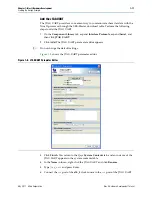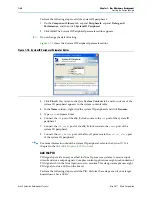
1–6
Chapter 1: Nios II Hardware Development
Nios II System Development Flow
Nios II Hardware Development Tutorial
May 2011
Altera Corporation
f
For more information about the following topics, refer to the related documentation:
■
For Nios II processor cores, refer to the
Nios II Processor Reference Handbook
■
For Qsys and developing custom components, refer to the
System Design with Qsys
section of
Volume 1: Design and Synthesis
Quartus II Handbook
.
■
For custom instructions, refer to the
Nios II Custom Instruction User Guide
Integrating the Qsys System into the Quartus II Project
After generating the Nios II system using Qsys, you integrate it into the Quartus II
project. Using the Quartus II software, you perform all tasks required to create the
final FPGA hardware design.
As shown in
, most FPGA designs include logic outside the
Nios II system. You can integrate your own custom hardware modules into the FPGA
design, or you can integrate other ready-made intellectual property (IP) design
modules available from Altera or third party IP providers. This tutorial does not cover
adding other logic outside the Nios II system.
Using the Quartus II software, you also assign pin locations for I/O signals, specify
timing requirements, and apply other design constraints. Finally, you compile the
Quartus II project to produce a .
sof
to configure the FPGA.
You download the .
sof
to the FPGA on the target board using an Altera download
cable, such as the USB-Blaster. After configuration, the FPGA behaves as specified by
the hardware design, which in this case is a Nios II processor system.
f
For further information about using the Quartus II software, refer to
, and the
Quartus II Software Interactive
Tutorial
section of the Altera website.
Developing Software with the Nios II Software Build Tools for Eclipse
Using the Nios II Software Build Tools (SBT) for Eclipse™, you perform all software
development tasks for your Nios II processor system. After you generate the system
with Qsys, you can begin designing your C/C++ application code immediately with
the Nios II SBT for Eclipse. Altera provides component drivers and a hardware
abstraction layer (HAL) which allows you to write Nios II programs quickly and
independently of the low-level hardware details. In addition to your application code,
you can design and reuse custom libraries in your Nios II SBT for Eclipse projects.
To create a new Nios II C/C++ application project, the Nios II SBT for Eclipse uses
information from the
.sopcinfo
file. You also need the
.sof
file to configure the FPGA
before running and debugging the application project on target hardware.
The Nios II SBT for Eclipse can produce several outputs, listed below. Not all projects
require all of these outputs.
■
system.h
file—Defines symbols for referencing the hardware in the system. The
Nios II SBT for Eclipse automatically create this file when you create a new board
support package (BSP).
■
Executable and Linking Format File (
.elf
)—Is the result of compiling a C/C++
application project, that you can download directly to the Nios II processor.











































